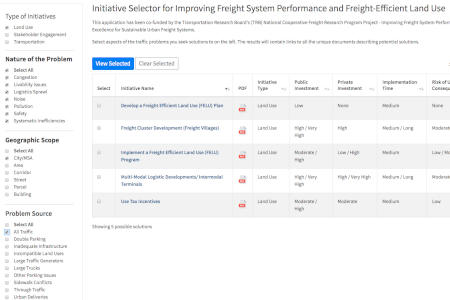Improving Freight System Performance in Metropolitan Areas
START YEAR: 2012
COMPLETION YEAR: 2014
TOPIC(S): Sustainable Freight Systems, Urban Freight, Transportation Planning
PRIMARY CONTACT(S):
- José Holguín-Veras,
- Jeffrey Wojtowicz
PARTNER(S):
- CDM Smith
- New York City Department of Transportation
- HDR
- Michael Browne
SPONSORS/FUNDING:
- The National Cooperative Freight Research Program Project 38 (NCFRP 38)

OVERVIEW
This project focuses on freight systems as a crucial economic and quality of life contributor, and a major source of environmental pollution, unwanted noise, and safety hazards. The primary goal of this project is to improve the overall performance of the urban freight industry.
The project will define a pragmatic and conceptually well-grounded planning guide that includes both supply and demand strategies (including hybrids), that is supported by solid guidelines to establish effective and proactive stakeholder engagement processes and software tools to estimate freight trip generation in urban areas. The project will provide practitioners with comprehensive, pragmatic, and actionable guidelines on how to plan, design, and implement both supply and demand strategies.
The public sector strategies (both supply and demand side) to be considered in the project will seek to achieve one or several of the following objectives:
- Reduce Congestion: Public agencies seek to reduce delays by either increasing capacity (which may induce demand and a return of congestion in the long term) or managing demand. This is an important objective because congestion delays are correlated with air pollution externalities, as well as economic inefficiency.
- Environmental Sustainability: The desire is to minimize environmental impacts, e.g., emissions, associated with freight activity. Often correlated with congestion reduction, it is not necessarily a cause and effect relationship; for instance, fostering the use of alternative fuels, efficient engines, and electric trucks reduces environmental impacts without impacting congestion.
- Enhance Safety: The main intent is to reduce the risk/severity of accidents. This is an important objective, particularly for local communities that tend to think of freight activity as the cause of traffic accidents.
- Enhance Security: In this case, transportation decision makers are looking to improve the ability of the freight system to repel security attacks that may compromise life and property, and to enhance the resiliency of the system to manmade or natural threats.
- Enhance Economic Competitiveness: The desired intent here is to foster economic activity in the study area. For instance, by means of freight-friendly land use policies, or by enhancing the efficiency of freight related economic activities.
- Revenue Generation: Increasingly transportation agencies are seeking to use fees and other forms of payment transfers to generate funds that can enhance the capabilities of the metropolitan area to perform its duties.
- Enhance Livability: These considerations seek to preserve the community culture, foster a positive synergy between business and residents, and seamlessly integrate freight activity into the fabric of the local communities.
KEY TASKS
- Identify and Summarize Applicable Research
- Identify Strategies and Initiate Stakeholder Engagement
- Identify Obstacles and Successes
- Prepare Interim Report
- Develop a Draft Planning Guide
- Develop Software Tool to Estimate Freight Trip Generation
- Gather Input from Stakeholders
- Revise the Draft Planning Guide
- Conduct Workshop
- Finalize and Disseminate the Planning Guide
- Produce Final Report
KEY FINDINGS
- FG and FTG are very different concepts: their modeling approaches follow different principles
- Using constant FTG rates is bound to produce large estimation errors
- Employment and establishment area are good variables to explain FG and FTG
- The type of economic activity is a key variable to estimate FTG
- Industry sectors are better proxies of economic activities than land use
- The aggregation procedure should be determined according to the disaggregated model specification
KEY PRODUCTS
ADDITIONAL PRODUCTS
- Holguín-Veras, J., Amaya, J., Sanchez-Diaz, I., Gonzalez-Calderon, C., Jaller, M., Wojtowicz, J., Wang, C., Browne, M., Hodge S., and Rhodes, S. Strategies to Improve Urban Freight Systems
- Presentation at the INFORMS Annual Meeting in Minneapolis, MN
- Presentation at the Fifth International Urban Freight Conference INUF-METRANS in Long Beach, CA
CONTRIBUTING TEAM MEMBERS
- José Holguín-Veras
- Cara Wang
- Johanna Amaya Leah
- Jeffrey Wojtowicz
- Ivan Sanchez-Diaz
- Carlos González-Calderón
- Miguel Jaller
RELATED PROJECTS
- Effective Decision-Making Methods for Freight-Efficient Land Use
- Collaborative Approaches to Foster Energy-Efficient Logistics in the Albany-New York City Corridor
